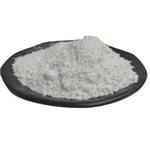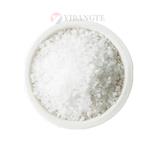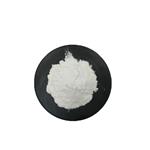Palmitic acid
- CAS No.
- 57-10-3
- Chemical Name:
- Palmitic acid
- Synonyms
- N-HEXADECANOIC ACID;HEXADECANOIC ACID;C16;palmitic;Palmic acid;CETYLIC ACID;1-Pentadecanecarboxylic acid;Hydrofol;PALMITINSAEURE;Hexadecylic acid
- CBNumber:
- CB9388222
- Molecular Formula:
- C16H32O2
- Molecular Weight:
- 256.42
- MDL Number:
- MFCD00002747
- MOL File:
- 57-10-3.mol
- MSDS File:
- SDS
| Melting point | 61-62.5 °C(lit.) |
|---|---|
| Boiling point | 351.5 °C |
| Density | 0.852 g/mL at 25 °C(lit.) |
| vapor pressure | 10 mm Hg ( 210 °C) |
| refractive index | 1.4273 |
| FEMA | 2832 | PALMITIC ACID |
| Flash point | >230 °F |
| storage temp. | room temp |
| solubility | chloroform: 0.5 M, clear, colorless |
| form | Flakes |
| pka | 4.78±0.10(Predicted) |
| color | White or almost white |
| Odor | at 100.00 %. slightly waxy fatty |
| Odor Type | waxy |
| Water Solubility | insoluble |
| Merck | 14,6996 |
| JECFA Number | 115 |
| BRN | 607489 |
| Dielectric constant | 2.3(71℃) |
| Stability | Stable. Combustible. Incompatible with bases, oxidizing agents, reducing agents. |
| InChIKey | IPCSVZSSVZVIGE-UHFFFAOYSA-N |
| LogP | 7.170 |
| Substances Added to Food (formerly EAFUS) | PALMITIC ACID |
| FDA 21 CFR | 357.210 |
| CAS DataBase Reference | 57-10-3(CAS DataBase Reference) |
| EWG's Food Scores | 1 |
| FDA UNII | 2V16EO95H1 |
| NIST Chemistry Reference | Hexadecanoic acid(57-10-3) |
| EPA Substance Registry System | Palmitic acid (57-10-3) |
SAFETY
Risk and Safety Statements
| Symbol(GHS) |  GHS07 |
|||||||||
|---|---|---|---|---|---|---|---|---|---|---|
| Signal word | Warning | |||||||||
| Hazard statements | H319 | |||||||||
| Precautionary statements | P305+P351+P338 | |||||||||
| Hazard Codes | Xi | |||||||||
| Risk Statements | 36-36/38-36/37/38 | |||||||||
| Safety Statements | 26-37/39-36 | |||||||||
| WGK Germany | - | |||||||||
| RTECS | RT4550000 | |||||||||
| TSCA | Yes | |||||||||
| HS Code | 29157015 | |||||||||
| Toxicity | LD50 i.v. in mice: 57±3.4 mg/kg (Or, Wretlind) | |||||||||
| NFPA 704 |
|
Palmitic acid price More Price(87)
| Manufacturer | Product number | Product description | CAS number | Packaging | Price | Updated | Buy |
|---|---|---|---|---|---|---|---|
| Sigma-Aldrich | W283215 | Palmitic acid natural, 98%, FG | 57-10-3 | 1kg | $101 | 2024-03-01 | Buy |
| Sigma-Aldrich | W283215 | Palmitic acid natural, 98%, FG | 57-10-3 | 10Kg | $468 | 2024-03-01 | Buy |
| Sigma-Aldrich | W283207 | Palmitic acid ≥95%, FCC, FG | 57-10-3 | 1kg | $76.5 | 2024-03-01 | Buy |
| Sigma-Aldrich | W283207 | Palmitic acid ≥95%, FCC, FG | 57-10-3 | 10Kg | $198 | 2024-03-01 | Buy |
| Sigma-Aldrich | W283207 | Palmitic acid ≥95%, FCC, FG | 57-10-3 | 25kg | $331 | 2024-03-01 | Buy |
Palmitic acid Chemical Properties,Uses,Production
Description
Palmitic acid is a kind of common saturated fatty acid of a 16-carbon backbone, which is contained in fats and waxes. It naturally exists in palm oil and palm kernel oil, and can also be found in butter, cheese, milk, meat, cocoa butter, soybean oil and sunflower oil. It can be produced by many kinds of plants and organisms. It can be used for the production of soap, cosmetics, and industrial mold release agents. It is also a food processing aid. It can also be used to produce cetyl alocohol which is useful in the production of detergents and cosmetics. Recently, it has been also used for the manufacture of a long-acting antipsychotic medication, paliperidone palmitate.
Chemical Properties
Palmitic acid occurs as white crystalline scales with a slight characteristic odor and taste. It is one of the most common saturated fatty acids found in animals and plants. It is a mixture of solid organic acids obtained from fats consisting chiefly of palmitic acid (C16H35O2) with varying amounts of stearic acid (C16H36O2). As its name tells us, it is found in palm oil but also in butter, cheese, milk and meat.
Occurrence
Reported found in apple, beef fat, preferments of bread, celery, cheddar cheese, blue cheese, roquefort cheese, other cheeses, roasted cocoa bean, cognac, country cured ham, essential oil of lemon, heated milk, essential oil of sweet orange, pork fat, potato, black tea, tomato, banana, grapefruit juice, cranberry, guava, grapes, melon, papaya, pear, raspberry, strawberry, cinnamon, ginger, saffron, milk powder, fatty fish, chicken, lamb, hop oil, beer, rum, whiskies, grape wines, peanut oil, popcorn, soybean, coconut meat, avocado, cloudberry, plums, beans, mushroom, starfruit, marjoram, fenugreek, mango, tamarind, fig, kelp, cardamom,rice, prickly pear, dill, licorice, sake, buckwheat, corn oil, malt, wort, roasted chicory root, lemon balm, shrimp, crab, clam, scallop, Chinese quince, pawpaw and sweet grass oil.
Uses
Palmitic Acid is a fatty acid which is a mixture of solid organic acids from fats consisting principally of palmitic acid with varying amounts of stearic acid. it functions as a lubricant, binder, and defoaming agent.
Uses
palmitic acid is one of the skin’s major fatty acids produced by the sebaceous glands. In cosmetic preparations, it is used as a formula texturizer. This acid is naturally occurring in allspice, anise, calamus oil, cascarilla bark, celery seed, coffee, tea, and many animal fats and plant oils. It is obtained from palm oil, Japan wax, or Chinese vegetable tallow.
Uses
Palmitic Acid is a common fatty acid found in plants and animals. The body converts excess carbohydrates into Palmitic Acid, thus Palmitic Acid is the first fatty acid produced during fatty acid synt hesis as well as a precursor for longer fatty acids.
Definition
ChEBI: Palmitic acid is a saturated long-chain fatty acid with a 16-carbon backbone. It is a metabolite found in the aging mouse brain. It is found naturally in palm oil and palm kernel oil, as well as in butter, cheese, milk and meat.
Application
Palmitic acid is mainly used to produce soaps, cosmetics, and release agents. These applications utilize sodium palmitate, which is commonly obtained by saponification of palm oil. To this end, palm oil, rendered from the coconut palm nut, is treated with sodium hydroxide (in the form of caustic soda or lye), which causes hydrolysis of the ester groups. This procedure affords glycerol and sodium palmitate.
Because it is inexpensive and adds texture to processed foods (convenience food), palmitic acid and its sodium salt find wide use including foodstuffs. Sodium palmitate is permitted as a natural additive in organic products.
Hydrogenation of palmitic acid yields cetyl alcohol, which is used to produce detergents and cosmetics.
Recently, a long-acting antipsychotic medication, paliperidone palmitate (marketed as INVEGA Sustenna), used in the treatment of schizophrenia, has been synthesized using the oily palmitate ester as a long-acting release carrier medium when injected intramuscularly. The underlying method of drug delivery is similar to that used with decanoic acid to deliver long-acting depot medication, in particular, neuroleptics such as haloperidol decanoate.
Production Methods
Palmitic acid occurs naturally in all animal fats as the glyceride, palmitin, and in palm oil partly as the glyceride and partly uncombined. Palmitic acid is most conveniently obtained from olive oil after removal of oleic acid, or from Japanese beeswax. Synthetically, palmitic acid may be prepared by heating cetyl alcohol with soda lime to 270°C or by fusing oleic acid with potassium hydrate.
Synthesis Reference(s)
The Journal of Organic Chemistry, 27, p. 2950, 1962 DOI: 10.1021/jo01055a527
Tetrahedron Letters, 17, p. 4697, 1976 DOI: 10.1016/S0040-4039(00)92999-X
Pharmaceutical Applications
Palmitic acid is used in oral and topical pharmaceutical formulations. Palmitic acid has been used in implants for sustained release of insulin in rats.
Biochem/physiol Actions
Palmitic acid (PA) is a component of membrane phospholipids (PL) and adipose triacylglycerols (TAG). Elevated levels of palmitic acid contributes to the pathophysiology of atherosclerosis, type 2 diabetes mellitus, neurodegenerative diseases, obesity and cancer. PA promotes apoptosis in the endothelial cell by modulating the p38 mitogen-activated protein kinase (MAPK) pathway and favors expression of TNF-α and reactive oxygen species accumulation. PA promotes interleukin 8 (IL-8) synthesis in hepatocytes contributing to hepatic inflammation. PA by interacting with toll-like receptor 4 (TLR4) induces inflammatory injury in cardiomyoctes.
Biotechnological Applications
Excess carbohydrates in the body are converted to palmitic acid. Palmitic acid is the first fatty acid produced during fatty acid synthesis and the precursor to longer fatty acids. Palmitate negatively feeds back on acetyl-CoA carboxylase (ACC), which is responsible for converting acetyl-CoA to malonyl-CoA, which in turn is used to add to the growing acyl chain, thus preventing further palmitate generation. In biology, some proteins are modified by the addition of a palmitoyl group in a process known as palmitoylation. Palmitoylation is important for membrane localisation of many proteins.
Safety Profile
A poison by intravenous route. A human skin irritant. Questionable carcinogen with experimental neoplastigenic data. When heated to decomposition it emits acrid smoke and irritating fumes
Safety
Palmitic acid is used in oral and topical pharmaceutical formulations
and is generally regarded as nontoxic and nonirritant at the
levels employed as an excipient. However, palmitic acid is reported
to be an eye and skin irritant at high levels and is poisonous by
intravenous administration.
LD50 (mouse, IV): 57 mg/kg
storage
The bulk material should be stored in a well-closed container in a cool, dry, place.
Purification Methods
Purify palmitic acid by slow (overnight) recrystallisation from hexane. Some samples are also crystallised from acetone, EtOH or EtOAc. The crystals are kept in air to lose solvent, or are pumped dry of solvent on a vacuum line. [Iwahashi et al. J Chem Soc, Faraday Trans 1 81 973 1985, pK: White J Am Chem Soc 72 1858 1950, Beilstein 2 IV 1157.]
Incompatibilities
Palmitic acid is incompatible with strong oxidizing agents and bases.
Regulatory Status
GRAS listed. Included in the FDA Inactive Ingredients Database (oral tablets). Included in nonparenteral medicines licensed in the UK.
Palmitic acid Preparation Products And Raw materials
Raw materials
1of2
Preparation Products
1of5
| Supplier | Tel | Country | ProdList | Advantage | |
|---|---|---|---|---|---|
| Hebei Mojin Biotechnology Co., Ltd | +8613288715578 | sales@hbmojin.com | China | 12453 | 58 |
| Hebei Jingbo New Material Technology Co., Ltd | +8619931165850 | hbjbtech@163.com | China | 1000 | 58 |
| Henan Fengda Chemical Co., Ltd | +86-371-86557731 +86-13613820652 | info@fdachem.com | China | 7377 | 58 |
| Capot Chemical Co.,Ltd. | 571-85586718 +8613336195806 | sales@capotchem.com | China | 29797 | 60 |
| Henan Tianfu Chemical Co.,Ltd. | +86-0371-55170693 +86-19937530512 | info@tianfuchem.com | China | 21695 | 55 |
| Shanghai Time Chemicals CO., Ltd. | +86-021-57951555 +8617317452075 | jack.li@time-chemicals.com | China | 1807 | 55 |
| Hangzhou FandaChem Co.,Ltd. | 008657128800458; +8615858145714 | fandachem@gmail.com | China | 9352 | 55 |
| Shanxi Naipu Import and Export Co.,Ltd | +86-13734021967 +8613734021967 | kaia@neputrading.com | China | 1011 | 58 |
| Shanghai Zheyan Biotech Co., Ltd. | 18017610038 | zheyansh@163.com | CHINA | 3620 | 58 |
| career henan chemical co | +86-0371-86658258 | sales@coreychem.com | China | 29914 | 58 |
Related articles
- Is the Palmitic Acid in Coconut Oil Unhealthy?
- Palmitic acid is a saturated fat. It’s naturally found in some animal products like meat and dairy, as well as in palm and coc....
- Nov 12,2019
View Lastest Price from Palmitic acid manufacturers
| Image | Update time | Product | Price | Min. Order | Purity | Supply Ability | Manufacturer | |
|---|---|---|---|---|---|---|---|---|
 |
2024-04-19 | Palmitic acid
57-10-3
|
US $5.00 / kg | 25kg | 99 | 10000kg/month | Hebei Yime New Material Technology Co., Ltd. | |
 |
2024-04-02 | Palmitic acid
57-10-3
|
US $0.00-0.00 / kg | 1kg | 99% | 50000kg | Hebei Yibangte Import and Export Co. , Ltd. | |
 |
2023-12-25 | palmitic acid
57-10-3
|
US $6.00 / kg | 1kg | 99% | 20000 | Hebei Jingbo New Material Technology Co., Ltd |
-

- Palmitic acid
57-10-3
- US $5.00 / kg
- 99
- Hebei Yime New Material Technology Co., Ltd.
-

- Palmitic acid
57-10-3
- US $0.00-0.00 / kg
- 99%
- Hebei Yibangte Import and Export Co. , Ltd.
-

- palmitic acid
57-10-3
- US $6.00 / kg
- 99%
- Hebei Jingbo New Material Technology Co., Ltd





